sensor FORD ESCAPE 2021 Owners Manual
[x] Cancel search | Manufacturer: FORD, Model Year: 2021, Model line: ESCAPE, Model: FORD ESCAPE 2021Pages: 589, PDF Size: 9.2 MB
Page 4 of 589

Contacting Us
Contacting Us
..................................................15
Introduction
About This Publication .................................
17
Using This Publication .................................
18
Symbols Glossary
Symbols Used on Your Vehicle .................
19
Data Privacy
Data Privacy .....................................................
22
Service Data ....................................................
23
Event Data ........................................................
23
Settings Data ..................................................
24
Connected Vehicle Data .............................
24
Mobile Device Data .......................................
25
Emergency Call System Data ...................
25
At a Glance
Instrument Panel ..........................................
26
Child Safety
Child Safety Precautions ............................
28
Child Restraint Anchor Points ..................
29
Child Restraints .............................................
30
Installing Child Restraints ...........................
31
Booster Seats .................................................
36
Child Safety Locks ........................................
38
Seatbelts
Seatbelt Precautions ...................................
39
Fastening the Seatbelts .............................
40
Sensitive Locking Mode .............................
40
Automatic Locking Mode ............................
41
Adjusting the Seatbelts During Pregnancy ....................................................
42
Adjusting the Seatbelt Height ..................
42
Seatbelt Reminder ........................................
42Checking the Seatbelts
..............................
44
Seatbelt Extensions .....................................
45
Personal Safety System ™
What Is the Personal Safety System ........................................................................\
..
46
How Does the Personal Safety System Work ..............................................................
46
Personal Safety System Components ........................................................................\
..
46
Airbags
How Do the Front Airbags Work ..............
47
How Do the Side Airbags Work ................
47
How Do the Knee Airbags Work ..............
48
How Does the Safety Canopy ™ Work
........................................................................\
..
48
Airbag Precautions .......................................
49
Properly Adjusting the Driver and Front Passenger Seats .......................................
50
Children and Airbags ...................................
50
Front Passenger Sensing System ............
51
Crash Sensors and Airbag Indicator .......
54
Disposing of Airbags ....................................
55
Pedestrian Alert System
What Is the Pedestrian Alert System ........................................................................\
..
56
911 Assist
What Is 911 Assist ..........................................
57
Emergency Call Requirements .................
57
Emergency Call Limitations .......................
57
Keys and Remote Controls
Remote Control Limitations .....................
58
Using the Remote Control .........................
58
Opening and Closing the Flip Key ...........
58
Removing the Key Blade ............................
59
Sounding the Panic Alarm .........................
59
Locating Your Vehicle ..................................
59
1
Escape (CTC) Canada/United States of America, Vehicles Built From: 02-11-2020, enUSA, Edition date: 202011, First-Printing Table of Contents
Page 12 of 589
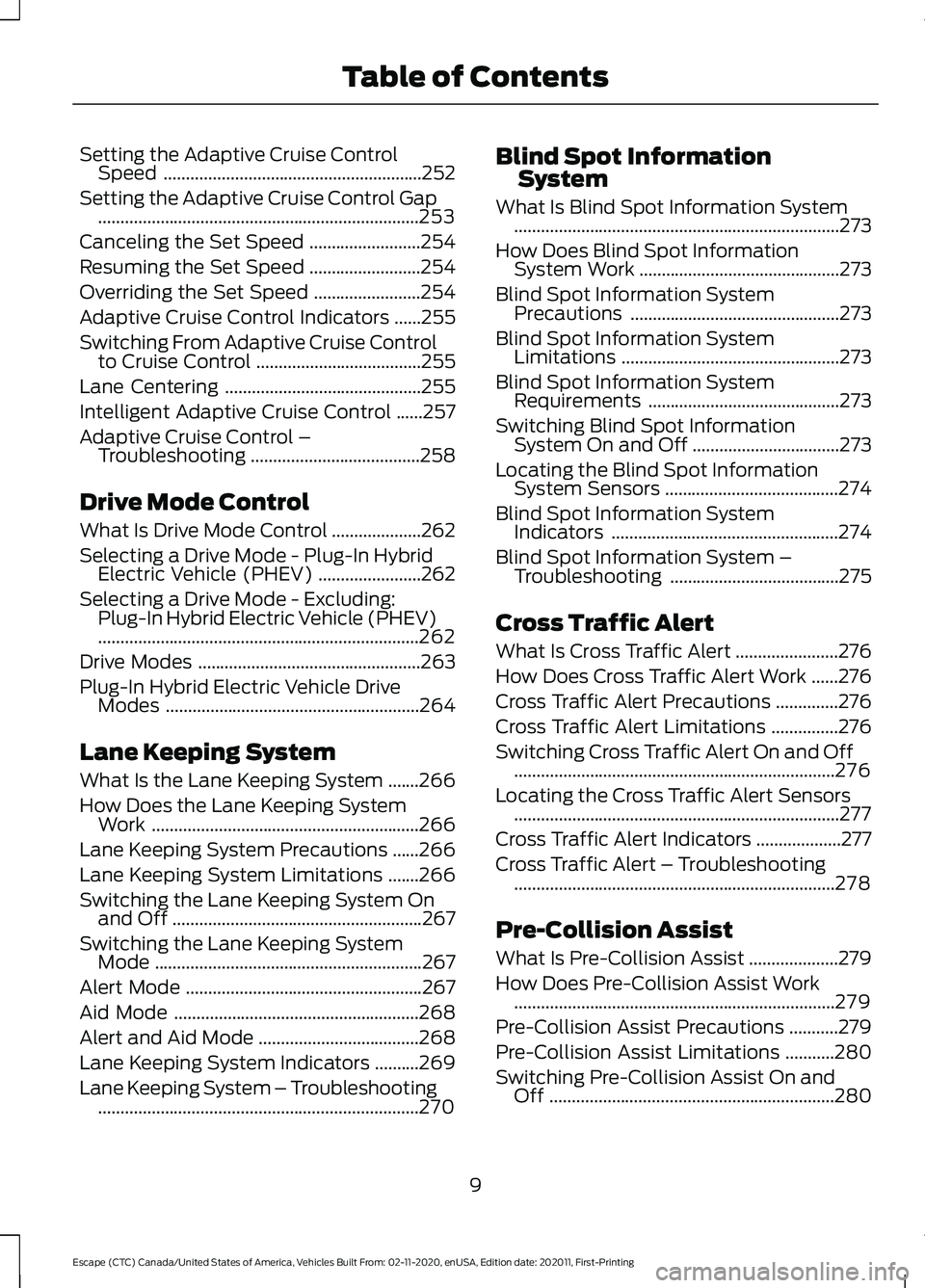
Setting the Adaptive Cruise Control
Speed ..........................................................252
Setting the Adaptive Cruise Control Gap ........................................................................\
253
Canceling the Set Speed .........................
254
Resuming the Set Speed .........................
254
Overriding the Set Speed ........................
254
Adaptive Cruise Control Indicators ......
255
Switching From Adaptive Cruise Control to Cruise Control .....................................
255
Lane Centering ............................................
255
Intelligent Adaptive Cruise Control ......
257
Adaptive Cruise Control – Troubleshooting ......................................
258
Drive Mode Control
What Is Drive Mode Control ....................
262
Selecting a Drive Mode - Plug-In Hybrid Electric Vehicle (PHEV) .......................
262
Selecting a Drive Mode - Excluding: Plug-In Hybrid Electric Vehicle (PHEV)
........................................................................\
262
Drive Modes ..................................................
263
Plug-In Hybrid Electric Vehicle Drive Modes .........................................................
264
Lane Keeping System
What Is the Lane Keeping System .......
266
How Does the Lane Keeping System Work ............................................................
266
Lane Keeping System Precautions ......
266
Lane Keeping System Limitations .......
266
Switching the Lane Keeping System On and Off ........................................................
267
Switching the Lane Keeping System Mode ............................................................
267
Alert Mode .....................................................
267
Aid Mode .......................................................
268
Alert and Aid Mode ....................................
268
Lane Keeping System Indicators ..........
269
Lane Keeping System – Troubleshooting ........................................................................\
270 Blind Spot Information
System
What Is Blind Spot Information System ........................................................................\
.
273
How Does Blind Spot Information System Work .............................................
273
Blind Spot Information System Precautions ...............................................
273
Blind Spot Information System Limitations .................................................
273
Blind Spot Information System Requirements ...........................................
273
Switching Blind Spot Information System On and Off .................................
273
Locating the Blind Spot Information System Sensors .......................................
274
Blind Spot Information System Indicators ...................................................
274
Blind Spot Information System – Troubleshooting ......................................
275
Cross Traffic Alert
What Is Cross Traffic Alert .......................
276
How Does Cross Traffic Alert Work ......
276
Cross Traffic Alert Precautions ..............
276
Cross Traffic Alert Limitations ...............
276
Switching Cross Traffic Alert On and Off ........................................................................\
276
Locating the Cross Traffic Alert Sensors ........................................................................\
.
277
Cross Traffic Alert Indicators ...................
277
Cross Traffic Alert – Troubleshooting ........................................................................\
278
Pre-Collision Assist
What Is Pre-Collision Assist ....................
279
How Does Pre-Collision Assist Work ........................................................................\
279
Pre-Collision Assist Precautions ...........
279
Pre-Collision Assist Limitations ...........
280
Switching Pre-Collision Assist On and Off ................................................................
280
9
Escape (CTC) Canada/United States of America, Vehicles Built From: 02-11-2020, enUSA, Edition date: 202011, First-Printing Table of Contents
Page 13 of 589
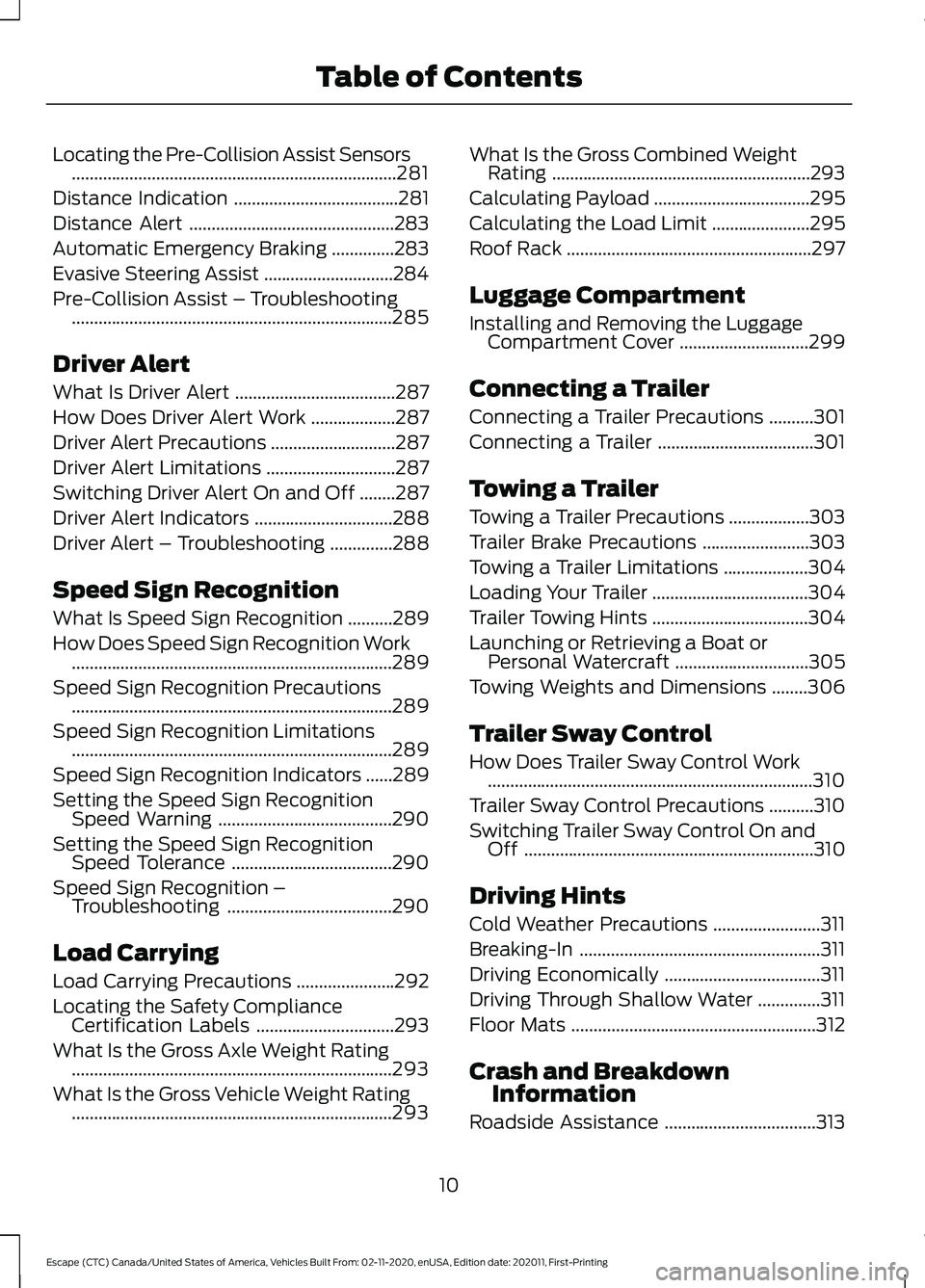
Locating the Pre-Collision Assist Sensors
........................................................................\
.281
Distance Indication .....................................
281
Distance Alert ..............................................
283
Automatic Emergency Braking ..............
283
Evasive Steering Assist .............................
284
Pre-Collision Assist – Troubleshooting ........................................................................\
285
Driver Alert
What Is Driver Alert ....................................
287
How Does Driver Alert Work ...................
287
Driver Alert Precautions ............................
287
Driver Alert Limitations .............................
287
Switching Driver Alert On and Off ........
287
Driver Alert Indicators ...............................
288
Driver Alert – Troubleshooting ..............
288
Speed Sign Recognition
What Is Speed Sign Recognition ..........
289
How Does Speed Sign Recognition Work ........................................................................\
289
Speed Sign Recognition Precautions ........................................................................\
289
Speed Sign Recognition Limitations ........................................................................\
289
Speed Sign Recognition Indicators ......
289
Setting the Speed Sign Recognition Speed Warning .......................................
290
Setting the Speed Sign Recognition Speed Tolerance ....................................
290
Speed Sign Recognition – Troubleshooting .....................................
290
Load Carrying
Load Carrying Precautions ......................
292
Locating the Safety Compliance Certification Labels ...............................
293
What Is the Gross Axle Weight Rating ........................................................................\
293
What Is the Gross Vehicle Weight Rating ........................................................................\
293 What Is the Gross Combined Weight
Rating ..........................................................
293
Calculating Payload ...................................
295
Calculating the Load Limit ......................
295
Roof Rack .......................................................
297
Luggage Compartment
Installing and Removing the Luggage Compartment Cover .............................
299
Connecting a Trailer
Connecting a Trailer Precautions ..........
301
Connecting a Trailer ...................................
301
Towing a Trailer
Towing a Trailer Precautions ..................
303
Trailer Brake Precautions ........................
303
Towing a Trailer Limitations ...................
304
Loading Your Trailer ...................................
304
Trailer Towing Hints ...................................
304
Launching or Retrieving a Boat or Personal Watercraft ..............................
305
Towing Weights and Dimensions ........
306
Trailer Sway Control
How Does Trailer Sway Control Work ........................................................................\
.
310
Trailer Sway Control Precautions ..........
310
Switching Trailer Sway Control On and Off .................................................................
310
Driving Hints
Cold Weather Precautions ........................
311
Breaking-In ......................................................
311
Driving Economically ...................................
311
Driving Through Shallow Water ..............
311
Floor Mats .......................................................
312
Crash and Breakdown Information
Roadside Assistance ..................................
313
10
Escape (CTC) Canada/United States of America, Vehicles Built From: 02-11-2020, enUSA, Edition date: 202011, First-Printing Table of Contents
Page 29 of 589

INSTRUMENT PANEL
Air vents.
A
Direction indicators. See Overriding Automatic High Beam Control (page
102).
B
Cruise controls. See
What Is Cruise Control (page 247).
C
Information Display. See
Instrument Cluster Overview (page 111).
D
Information display controls and audio controls. See
Using the Instrument
Cluster Display Controls (page 123). See Muting the Audio (page 415).
E
Wiper lever. See
Switching Windshield Wipers On and Off (page 92).
F
Touchscreen display.
G
Audio unit controls. See
Playing or Pausing the Audio Source (page 414).
H
Hazard flasher. See Switching the Hazard Flashers On and Off (page 315).
I
Passenger airbag deactivation indicator. See
Crash Sensors and Airbag
Indicator (page 54).
J
Glove compartment.
K
Climate controls. See
Automatic Climate Control (page 141).
L
Push button ignition switch. See
Push Button Ignition Switch (page 173).
M
26
Escape (CTC) Canada/United States of America, Vehicles Built From: 02-11-2020, enUSA, Edition date: 202011, First-Printing At a GlanceE285284
Page 43 of 589

•
Seatbelt pretensioners at the front
outermost and second row outermost
seating positions.
• Belt tension sensor at the front
outermost passenger seating position. A seatbelt warning light and
chime.
Crash sensors and monitoring
system with readiness indicator.
The seatbelt pretensioners are designed
to tighten the seatbelts when activated. In
frontal and near-frontal crashes, the
seatbelt pretensioners may be activated
alone or, if the crash is of sufficient severity,
together with the front airbags. The
pretensioners may also activate when a
Safety Canopy airbag deploys.
FASTENING THE SEATBELTS 1. Insert the belt tongue into the proper
buckle, the buckle closest to the
direction the tongue is coming from,
until it engages.
Note: Make sure that the seatbelt tongue
is properly fastened in the seatbelt buckle. 2.
Press the button to release the seatbelt
tongue. When in use, place the rear seatbelts in the
belt guides on the outermost seat
backrests.
SENSITIVE LOCKING MODE
What is Sensitive Locking Mode
Sensitive locking mode is a seatbelt
retractor feature that allows shoulder belt
length adjustment according to your
movements and locking in response to
vehicle movement.
40
Escape (CTC) Canada/United States of America, Vehicles Built From: 02-11-2020, enUSA, Edition date: 202011, First-Printing SeatbeltsE71880 E67017 E142587 E142588 E142589
Page 49 of 589
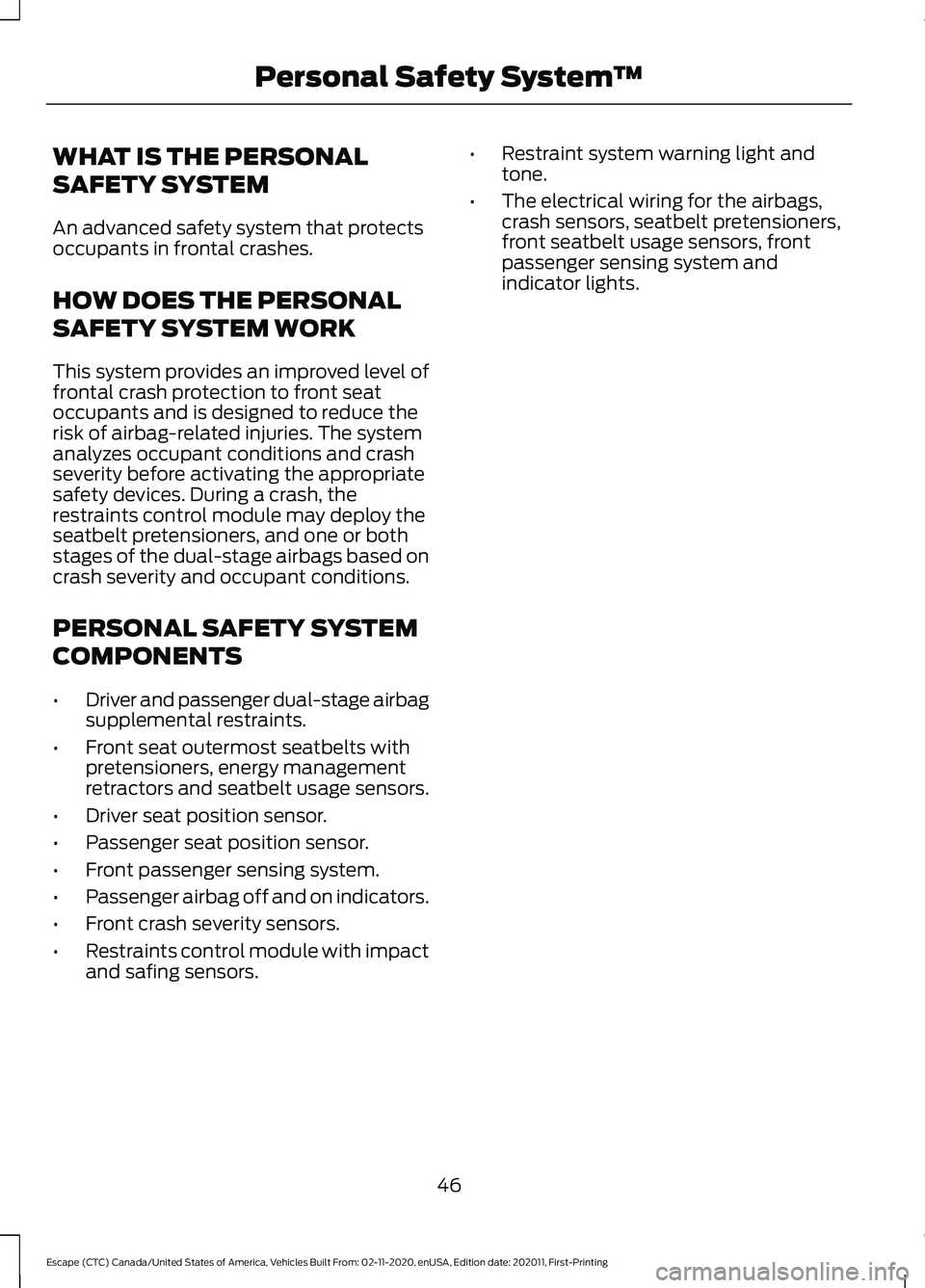
WHAT IS THE PERSONAL
SAFETY SYSTEM
An advanced safety system that protects
occupants in frontal crashes.
HOW DOES THE PERSONAL
SAFETY SYSTEM WORK
This system provides an improved level of
frontal crash protection to front seat
occupants and is designed to reduce the
risk of airbag-related injuries. The system
analyzes occupant conditions and crash
severity before activating the appropriate
safety devices. During a crash, the
restraints control module may deploy the
seatbelt pretensioners, and one or both
stages of the dual-stage airbags based on
crash severity and occupant conditions.
PERSONAL SAFETY SYSTEM
COMPONENTS
•
Driver and passenger dual-stage airbag
supplemental restraints.
• Front seat outermost seatbelts with
pretensioners, energy management
retractors and seatbelt usage sensors.
• Driver seat position sensor.
• Passenger seat position sensor.
• Front passenger sensing system.
• Passenger airbag off and on indicators.
• Front crash severity sensors.
• Restraints control module with impact
and safing sensors. •
Restraint system warning light and
tone.
• The electrical wiring for the airbags,
crash sensors, seatbelt pretensioners,
front seatbelt usage sensors, front
passenger sensing system and
indicator lights.
46
Escape (CTC) Canada/United States of America, Vehicles Built From: 02-11-2020, enUSA, Edition date: 202011, First-Printing Personal Safety System
™
Page 50 of 589
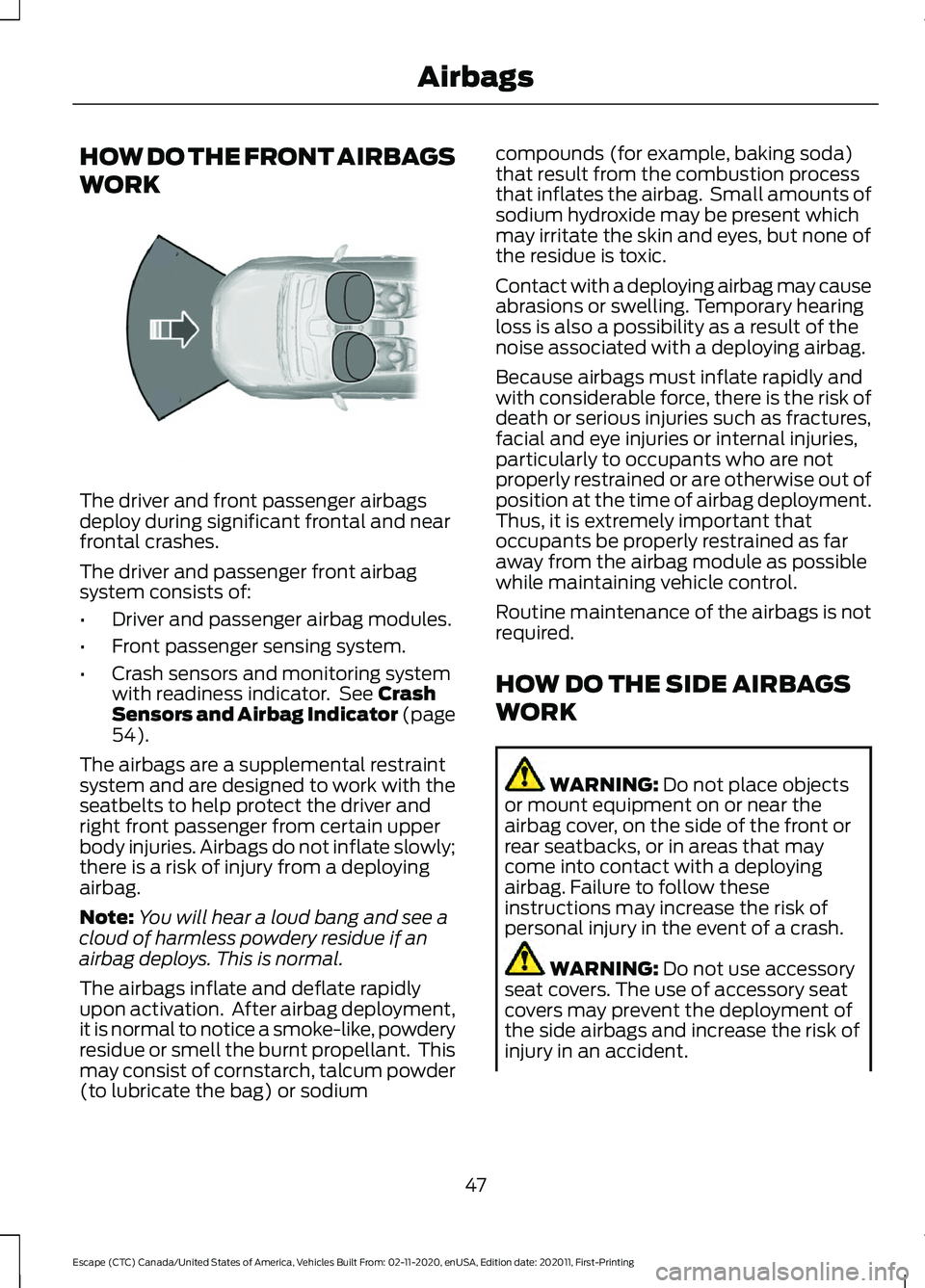
HOW DO THE FRONT AIRBAGS
WORK
The driver and front passenger airbags
deploy during significant frontal and near
frontal crashes.
The driver and passenger front airbag
system consists of:
•
Driver and passenger airbag modules.
• Front passenger sensing system.
• Crash sensors and monitoring system
with readiness indicator. See Crash
Sensors and Airbag Indicator (page
54
).
The airbags are a supplemental restraint
system and are designed to work with the
seatbelts to help protect the driver and
right front passenger from certain upper
body injuries. Airbags do not inflate slowly;
there is a risk of injury from a deploying
airbag.
Note: You will hear a loud bang and see a
cloud of harmless powdery residue if an
airbag deploys. This is normal.
The airbags inflate and deflate rapidly
upon activation. After airbag deployment,
it is normal to notice a smoke-like, powdery
residue or smell the burnt propellant. This
may consist of cornstarch, talcum powder
(to lubricate the bag) or sodium compounds (for example, baking soda)
that result from the combustion process
that inflates the airbag. Small amounts of
sodium hydroxide may be present which
may irritate the skin and eyes, but none of
the residue is toxic.
Contact with a deploying airbag may cause
abrasions or swelling. Temporary hearing
loss is also a possibility as a result of the
noise associated with a deploying airbag.
Because airbags must inflate rapidly and
with considerable force, there is the risk of
death or serious injuries such as fractures,
facial and eye injuries or internal injuries,
particularly to occupants who are not
properly restrained or are otherwise out of
position at the time of airbag deployment.
Thus, it is extremely important that
occupants be properly restrained as far
away from the airbag module as possible
while maintaining vehicle control.
Routine maintenance of the airbags is not
required.
HOW DO THE SIDE AIRBAGS
WORK
WARNING:
Do not place objects
or mount equipment on or near the
airbag cover, on the side of the front or
rear seatbacks, or in areas that may
come into contact with a deploying
airbag. Failure to follow these
instructions may increase the risk of
personal injury in the event of a crash. WARNING:
Do not use accessory
seat covers. The use of accessory seat
covers may prevent the deployment of
the side airbags and increase the risk of
injury in an accident.
47
Escape (CTC) Canada/United States of America, Vehicles Built From: 02-11-2020, enUSA, Edition date: 202011, First-Printing Airbags E151127
Page 51 of 589
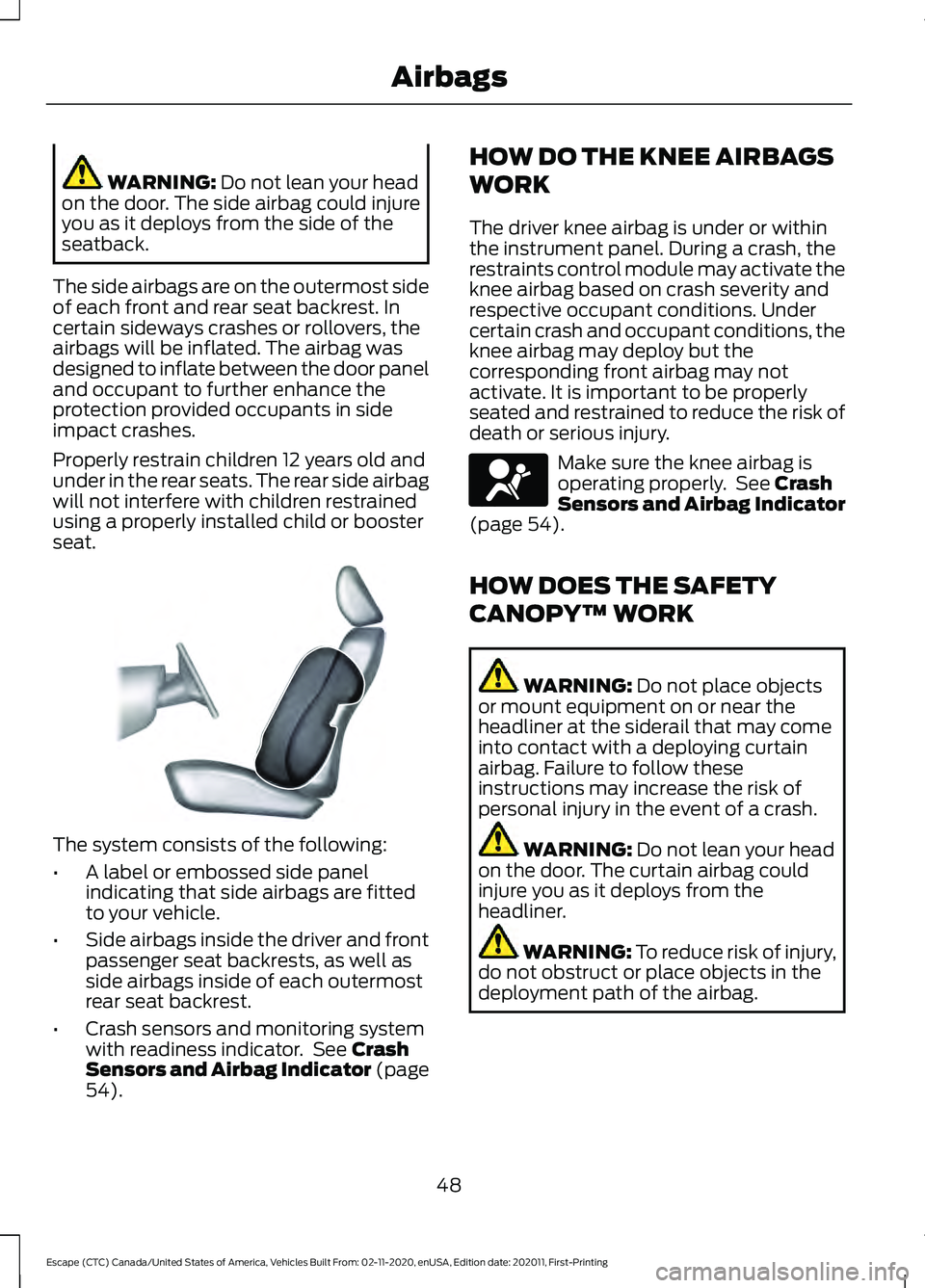
WARNING: Do not lean your head
on the door. The side airbag could injure
you as it deploys from the side of the
seatback.
The side airbags are on the outermost side
of each front and rear seat backrest. In
certain sideways crashes or rollovers, the
airbags will be inflated. The airbag was
designed to inflate between the door panel
and occupant to further enhance the
protection provided occupants in side
impact crashes.
Properly restrain children 12 years old and
under in the rear seats. The rear side airbag
will not interfere with children restrained
using a properly installed child or booster
seat. The system consists of the following:
•
A label or embossed side panel
indicating that side airbags are fitted
to your vehicle.
• Side airbags inside the driver and front
passenger seat backrests, as well as
side airbags inside of each outermost
rear seat backrest.
• Crash sensors and monitoring system
with readiness indicator. See
Crash
Sensors and Airbag Indicator (page
54
). HOW DO THE KNEE AIRBAGS
WORK
The driver knee airbag is under or within
the instrument panel. During a crash, the
restraints control module may activate the
knee airbag based on crash severity and
respective occupant conditions. Under
certain crash and occupant conditions, the
knee airbag may deploy but the
corresponding front airbag may not
activate. It is important to be properly
seated and restrained to reduce the risk of
death or serious injury.
Make sure the knee airbag is
operating properly. See
Crash
Sensors and Airbag Indicator
(page
54).
HOW DOES THE SAFETY
CANOPY™ WORK WARNING:
Do not place objects
or mount equipment on or near the
headliner at the siderail that may come
into contact with a deploying curtain
airbag. Failure to follow these
instructions may increase the risk of
personal injury in the event of a crash. WARNING:
Do not lean your head
on the door. The curtain airbag could
injure you as it deploys from the
headliner. WARNING:
To reduce risk of injury,
do not obstruct or place objects in the
deployment path of the airbag.
48
Escape (CTC) Canada/United States of America, Vehicles Built From: 02-11-2020, enUSA, Edition date: 202011, First-Printing AirbagsE152533 E67017
Page 52 of 589
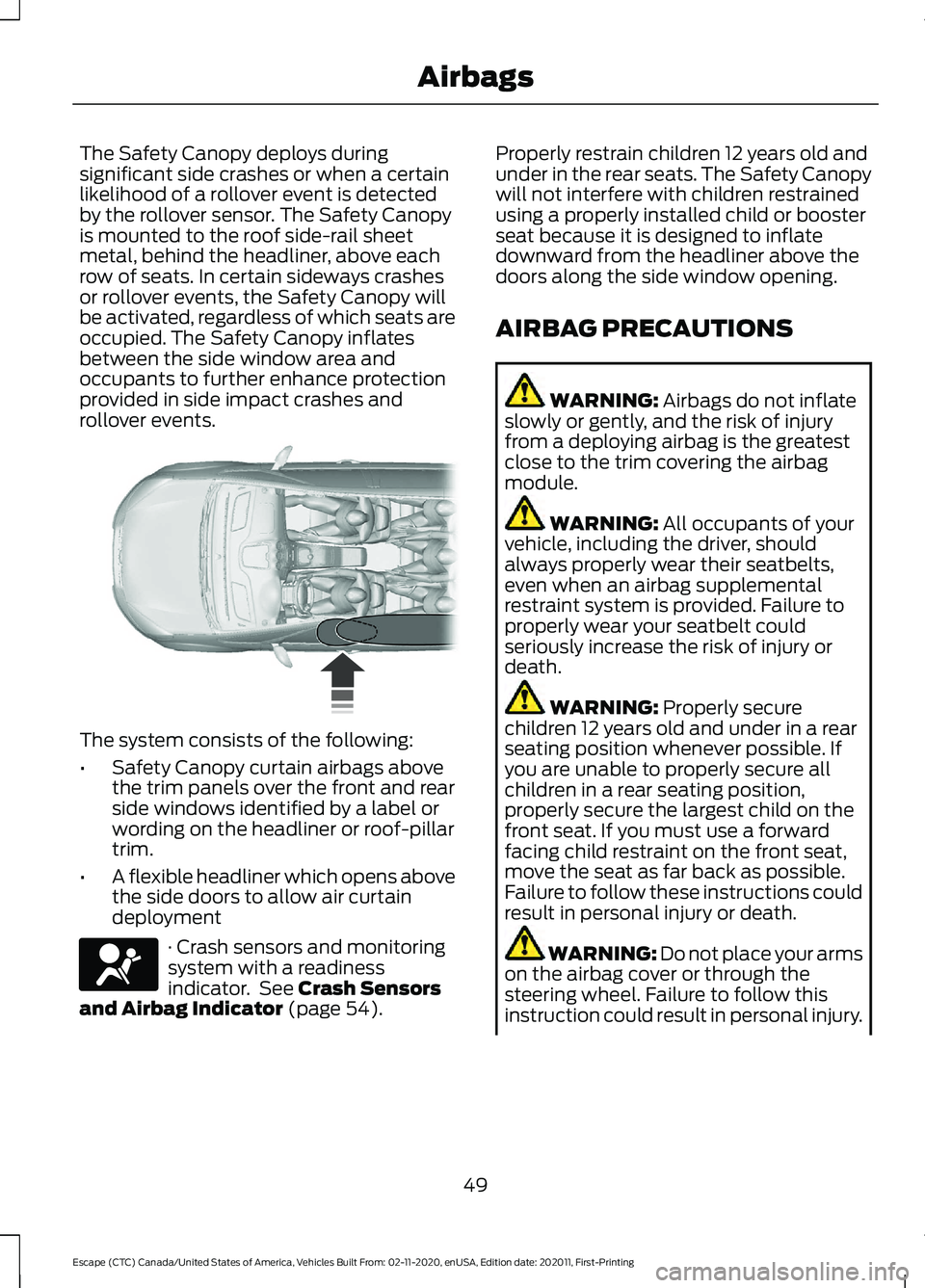
The Safety Canopy deploys during
significant side crashes or when a certain
likelihood of a rollover event is detected
by the rollover sensor. The Safety Canopy
is mounted to the roof side-rail sheet
metal, behind the headliner, above each
row of seats. In certain sideways crashes
or rollover events, the Safety Canopy will
be activated, regardless of which seats are
occupied. The Safety Canopy inflates
between the side window area and
occupants to further enhance protection
provided in side impact crashes and
rollover events.
The system consists of the following:
•
Safety Canopy curtain airbags above
the trim panels over the front and rear
side windows identified by a label or
wording on the headliner or roof-pillar
trim.
• A flexible headliner which opens above
the side doors to allow air curtain
deployment · Crash sensors and monitoring
system with a readiness
indicator. See Crash Sensors
and Airbag Indicator (page 54). Properly restrain children 12 years old and
under in the rear seats. The Safety Canopy
will not interfere with children restrained
using a properly installed child or booster
seat because it is designed to inflate
downward from the headliner above the
doors along the side window opening.
AIRBAG PRECAUTIONS
WARNING:
Airbags do not inflate
slowly or gently, and the risk of injury
from a deploying airbag is the greatest
close to the trim covering the airbag
module. WARNING:
All occupants of your
vehicle, including the driver, should
always properly wear their seatbelts,
even when an airbag supplemental
restraint system is provided. Failure to
properly wear your seatbelt could
seriously increase the risk of injury or
death. WARNING:
Properly secure
children 12 years old and under in a rear
seating position whenever possible. If
you are unable to properly secure all
children in a rear seating position,
properly secure the largest child on the
front seat. If you must use a forward
facing child restraint on the front seat,
move the seat as far back as possible.
Failure to follow these instructions could
result in personal injury or death. WARNING:
Do not place your arms
on the airbag cover or through the
steering wheel. Failure to follow this
instruction could result in personal injury.
49
Escape (CTC) Canada/United States of America, Vehicles Built From: 02-11-2020, enUSA, Edition date: 202011, First-Printing Airbags E75004 E67017
Page 54 of 589
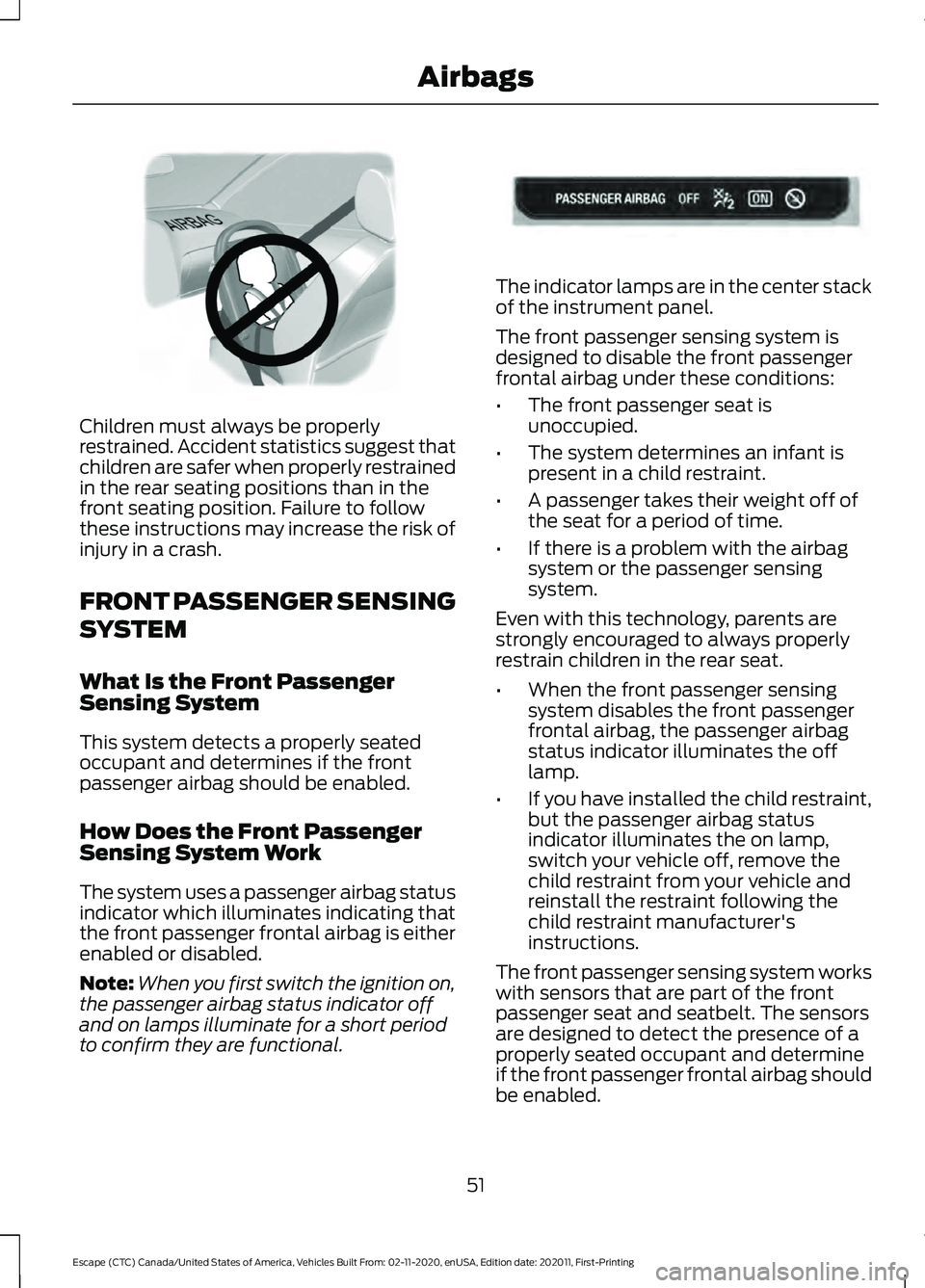
Children must always be properly
restrained. Accident statistics suggest that
children are safer when properly restrained
in the rear seating positions than in the
front seating position. Failure to follow
these instructions may increase the risk of
injury in a crash.
FRONT PASSENGER SENSING
SYSTEM
What Is the Front Passenger
Sensing System
This system detects a properly seated
occupant and determines if the front
passenger airbag should be enabled.
How Does the Front Passenger
Sensing System Work
The system uses a passenger airbag status
indicator which illuminates indicating that
the front passenger frontal airbag is either
enabled or disabled.
Note:
When you first switch the ignition on,
the passenger airbag status indicator off
and on lamps illuminate for a short period
to confirm they are functional. The indicator lamps are in the center stack
of the instrument panel.
The front passenger sensing system is
designed to disable the front passenger
frontal airbag under these conditions:
•
The front passenger seat is
unoccupied.
• The system determines an infant is
present in a child restraint.
• A passenger takes their weight off of
the seat for a period of time.
• If there is a problem with the airbag
system or the passenger sensing
system.
Even with this technology, parents are
strongly encouraged to always properly
restrain children in the rear seat.
• When the front passenger sensing
system disables the front passenger
frontal airbag, the passenger airbag
status indicator illuminates the off
lamp.
• If you have installed the child restraint,
but the passenger airbag status
indicator illuminates the on lamp,
switch your vehicle off, remove the
child restraint from your vehicle and
reinstall the restraint following the
child restraint manufacturer's
instructions.
The front passenger sensing system works
with sensors that are part of the front
passenger seat and seatbelt. The sensors
are designed to detect the presence of a
properly seated occupant and determine
if the front passenger frontal airbag should
be enabled.
51
Escape (CTC) Canada/United States of America, Vehicles Built From: 02-11-2020, enUSA, Edition date: 202011, First-Printing AirbagsE142846 E181984